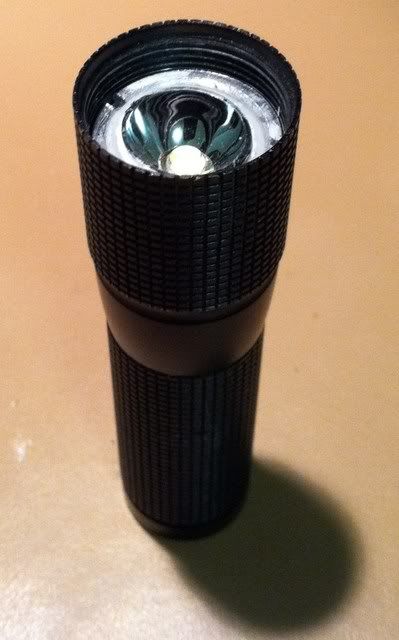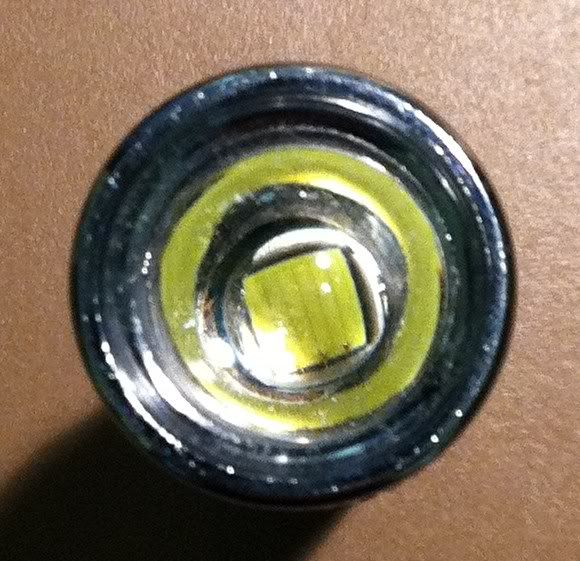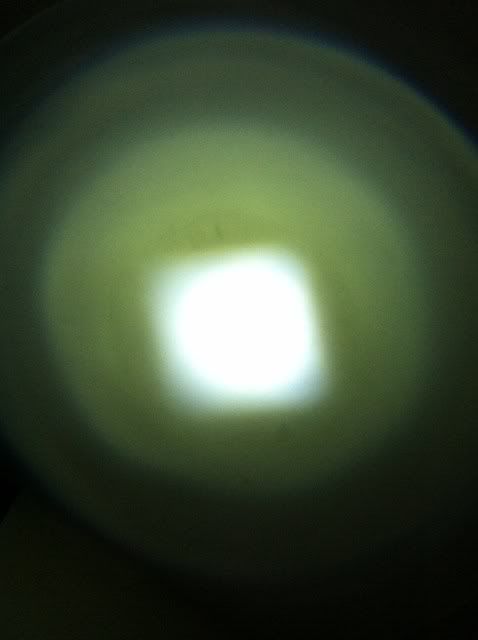I've contemplated sticking a ring of mylar inside the light to see what happens... My guess is it results in a lot of flood even when in zoom mode, but it's free light, not dimming the spot at all. Try it and let us know? :)
--Bushytails
I've contemplated sticking a ring of mylar inside the light to see what happens... My guess is it results in a lot of flood even when in zoom mode, but it's free light, not dimming the spot at all. Try it and let us know? :)
--Bushytails
Coating the inside of the aspheric's bezel with a more reflective material (mylar, white paint, etc.) would probably yield a bit of extra spill in spot mode. It wouldn't dim the output at all.
In my own EDC aspheric, I took a small plastic reflector from another light. In flood mode, the reflector goes from the base of the LED to within a mm of the back of the lens, so almost everything in that mode should be reflected out the front. The effect is pretty nice: Flood mode is much brighter, has no rings, and has a wide diffuse hotspot.
I still lose a lot of output in spot mode, but the reflector adds some spill, which I find to be very useful inspot and halfway modes.
I haven't tried coating the inside of the bezel with reflective paint or material. In my modifed SK58 the side of the pill slides across this area. I'm worried that it would scrape off or cook any paint or relective material I tried to apply.
Still, I should go get some Mylar and give it a shot.
Cree should do something like the XP-G or XM-L with primary optics. Just as they did with the XR-E.
Coast uses moving TIRs for their flood-to-throw lights.
I have a dorcy 1xAAA aspheric zoomable stainless steel light. The inside of the zoomable portion is threaded stainless steel so is quite shiny. Unfortunately, when zoomed every single thread appears as a ring around the spot, producing the world's ringiest beam!
I do think it would be worthwhile having a reflective surface on the inside of the bezel if the inside were smoother. Or if a more diffuse reflective surface were used such as white paint.
Part of it depends on how close you can get the LED to the lens If the LED isn't right next to the lens in flood mode some of the light will be lost sideways especially if using an XM-L or XP-G emitter with their wide angle output.
With many cheap aspherics it's not practical to get the LED right up against the lens because the place for mounting the star is recessed slightly into the pill, and the pill itself prevents the lens from moving closer to the LED. However, there is room to mount a small reflector, which can make a very noticeable difference in the beam's output even in flood mode.
In spot and halfway mode, the small reflector adds a usable amount of spill that is otherwise completely lacking. The spill in those modes may be ugly, but I've found it produces a much more useful beam.
my led lenser h7 also uses a movable tir, it is losing far less light when zoomed than aspheric (ceiling test zoomed in/out against nf-500)
That's it! You could use a spinning cup of mercury around the emitter. The faster you spin it, the steeper the resulting parabola, giving you a nice spot. Slow it down, parabola flattens out, you get a nice flood. Of course, the light would have to point straight up all the time for this to work...
--Bushytails
What about something like the recoil throwers with a bigger mirror and then the ability to move the led in and out relative to the mirror?
aspheric+reflector: You have seen the images in this post?
Be-Seen Triker: -properly- reflecting the lost light back into the aspheric is tough. I will be working on the reflection angles for this problem sometime soon and will post up the data.
You can't "reroute" the "lost spill" to make it contribute to the spot. It's not possible by laws of optics.
Well, there is a way to indirectly and partially achieve that though: Reflect the side beams directly back onto the LED itself like the 'Wavien collar'. That back reflected light increases the die's luminance ("surface brightness") and thus throw.
Haggai: But a led with a shallow reflector gives flood light, a led with a deep reflector gives good throw.
Not really, the main reason for throw is diameter (and SMO), not depth; here's some info.
Fortunately that specific one won't have any effect as it's too flat and shallow, all the rays hitting it do so in a very flat angle and be reflected to the walls...
I say fortunately, because if it did hit the lens, artifacts like in the images here are unavoidable. There'll always be an ugly gap between spot and reflector-'spill'.
Those artifacts are, however, free light. They don't use any extra battery power nor dim the spot any. Other than objecting to their appearance, there's no reason not to have them.
--Bushytails
Exactly.
What I've found is that in flood mode all artifacts blend away into the beam and are invisible. The beam looks perfect with a noticeably brighter wide diffuse hotspot in the center.
In spot mode, you can see every artifact and blemish in the reflector. This appears in a wide halo around the spot. But as the previous poster pointed out this is free light. And its bright enough to serve as usable spill ... something an aspheric without a reflector doesn't have.
Also with a properly chosen reflector and a big die like an XM-L, the reflector's halo only separates from the image of the die at full spot mode. At halfway mode, they still blend together producing an image that looks similar to that of a ringy smooth conventional reflector like setup for throw.
Here's some pics:
Modified Sipik SK58 with XM-L and reflector taken from old underwater kinetics 2xAAA incandescent. Lens is off:

Here's a pic down the business end of the light in full flood mode with the reflector and lens on:

Here's a beamshot in full flood mode. The reflector eliminates all rings in this mode while adding a wide diffuse spot in the center of the beam. Unlike other zoomies there also are no rings outside of the spill in this mode. I love how flood mode looks. Much floodier than the beam from a Xeno E03. And much brighter too with the driver I'm using. Note that the actual light output is not green-tinged at all. My cell phone pictures don't do it justice.

Halfway mode. This looks a lot uglier, but on the other hand the reflector is providing usable spill. Without the reflector everything outside of the bright spot in the center is gone:

Full spot mode. Note the halo and artifacts from the reflector. The beam is pretty ugly, but in real-world use this halo is bright enough to serve as usable spill, without affecting the light's throw:

Note that all modifications on this light were performed using my own rather amateurish do-it-yourself methods. Nothing professional quality about this mod.
I'm in the other camp anyway...I do care about beam quality. I don't like or use flood to throw lights anyway but regarding aspheric throwers I'm quite OK with it being like a laser with no spill rather than having the throw effect spoiled (for me) by having a disco light show going on around my head :)
As Dr. Jones has explained (and as I also understand it) you can't reflect the light back into the aspheric anyway. It has to take it from the emitter through it's focal point...anything else doesn't make the trip (which is why you lose some lumens).
Multi-purpose anything usually doesn't fair as well as task dedicated gear. It's easier to take two small lights than to try to make one that does it all (poorly) IMO.
The reflector was from the xenon lamp module of an old Underwater Kinetics 2xAAA light.

It came pre-focused for spot mode with its xenon bulb. I sawed through the bottom of the plastic reflector with a hobby saw, rotating the reflector when I hit the bulb inside When I'd gone all the way around it, I pulled off the reflector and discarded the rest. Then I used a drill matched to the width of the XM-L emitter to widen the hole slightly. I used arctic alumina thermal epoxy to glue the reflector to the white plastic retaining ring that came with the SK58 and was originally used to hold in the metal washer around the emitter.
It looks like Underwater Kinetics still sells these lamp modules. I find they reflect considerably more light than the reflector from a 2xAAA maglite, which I've also tried.
http://www.uwkinetics.com/products/uk2aaa-xenon-mini-pocket-light
Note that I made no attempt to try to get the reflector to perfectly focus the emitter die. It really isn't necessary with this setup. My goal was to make a more beautiful flood mode while giving some usable spill in spot mode and that's what this setup gives.
http://www.candlepowerforums.com/vb/showthread.php?283368-I-have-this-idea...
I have wondered about this before myself ...
with a push-pull mechanism to alter depth..........

The problem with a design like that is it wouldn't work very well at anything other than one setting... The blades have a fixed shape, they're just moved towards/away from the right position for that shape. And chances are your beam would end up shaped like the number of blades, too. Of course, this might be acceptable - having them the wrong shape is kinda like defocusing... So try it and let us know how it works. :)
--Bushytails
If you are interested in how this works, see this: http://www.newscientist.com/article/dn14030-liquidmirror-telescopes-are-a-reality-at-last.html